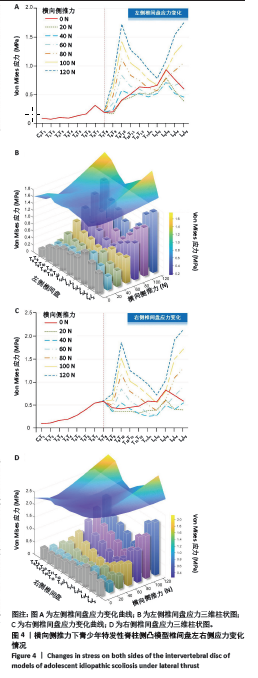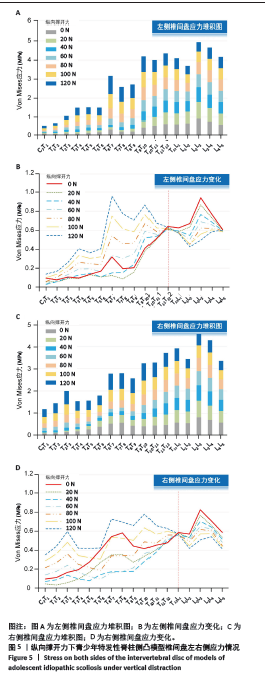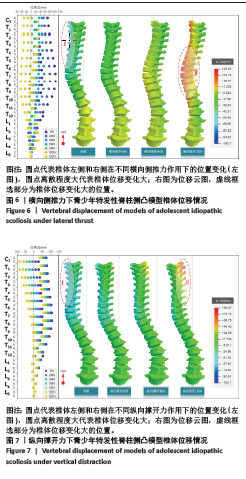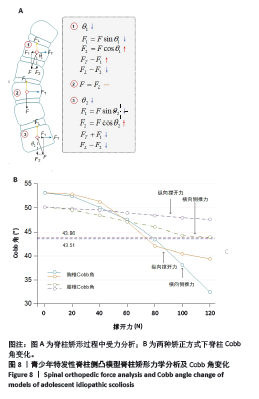[1] ROYE BD, SIMHON ME, MATSUMOTO H, et al. Establishing consensus on the best practice guidelines for the use of bracing in adolescent idiopathic scoliosis. Spine Deform. 2020;8:597-604.
[2] GANJAVIAN MS, PARNIANPOUR M, GOHARI E, et al. Numerical analysis (finite element method) of brace effects on the adolescent idiopatic scolosis during 24 hours. Biomed Eng. 2014;26(3):1450046.
[3] LI QY, ZHONG GB, LIU ZD, et al. Effect of asymmetric tension on biomechanics and metabolism of vertebral epiphyseal plate in a rodent model of scoliosis. Orthop Surg. 2017;9(3):311-318.
[4] AROEIRA R, PERTENCE A, KEMMOKU DT, et al. The effect of hypokyphosis on the biomechanical behavior of the adolescent thoracic spine. J Braz Soc Mech Sci. 2018;40(3):1-10.
[5] DUPUIS S, FORTIN C, CAOUETTE C, et al. Global postural re-education in pediatric idiopathic scoliosis: a biomechanical modeling and analysis of curve reduction during active and assisted self-correction. BMC Musculoskelet Disord. 2018;19(1):200.
[6] BIDARI S, KAMYAB M, GHANDHARI H, et al. Effcacy of computer-aided design and manufacturing versus computer-aided design and fnite element modeling technologies in brace management of idiopathic scoliosis: a narrative review. Asian Spine J. 2021;15(2):271-282.
[7] KONIECZNY MR, SENYURT H, KRAUSPE R. Epidemiology of adolescent idiopathic scoliosis. J Child Orthop. 2013;7(1):3-9.
[8] WEINSTEIN SL, DOLAN LA, CHENG JC, et al. Adolescent idiopathic scoliosis. Lancet. 2008;371(9623):1527-1537.
[9] GOLDBERG CJ, MOORE DP, FOGARTY EE, et al. Adolescent idiopathic scoliosis: the effect of brace treatment on the incidence of surgery. Spine. 2001;26(1):42-47.
[10] HARRINGTON PR. Treatment of scoliosis: correction and internal fixation by spine instrumentation. JBJS. 1962;44(4):591-634.
[11] MAJDOULINE Y, AUBIN CE, ROBITAILLE M, et al. Scoliosis correction objectives in adolescent idiopathic scoliosis. J Pediatr Orthop. 2007; 27(7):775-781.
[12] MEHLMAN CT, ARAGHI A, ROY DR. Hyphenated history: the hueter- volkmann law. Am J Orthop. 1997;26(11):798-800.
[13] BREKELMANS WA, POORT HW, SLOOFF TJ. A new method to analyse the mechanical behaviour of skeletal parts. Acta Orthop Scand. 1972; 43(5):301-317.
[14] 张宏其, 王永福, 唐明星, 等. Lenke5型青少年特发性脊柱侧凸手术矫形的有限元研究[J]. 脊柱外科杂志,2011,9(2):112-116.
[15] 邬超, 高明杰, 王建忠, 等. 有限元法分析Lenke 3型青少年特发性脊柱侧凸胸-腰椎的应力及位移变化[J]. 中国组织工程研究,2021, 25(33):5273-5280.
[16] FINLEY SM, BRODKE DS, SPINA NT, et al. FEBio finite element models of the human lumbar spine. Comput Methods Biomech Biomed Eng. 2018;21(6):444-452.
[17] 海涌, 潘爱星, 李永刚. 早发性脊柱侧凸不同生长棒固定方式对邻近节段生物力学的影响[J]. 中华医学杂志,2017,97(48):3768-3773.
[18] CAHILL PJ, WANG W, ASGHAR J, et al. The use of a transition rod may prevent proximal junctional kyphosis in the thoracic spine following scoliosis surgery: a finite element analysis. Spine (Phila Pa 1976). 2012; 37(12):687-695.
[19] WHITE AA, PANJABI MM. Clinical Biomechanics of the Spine. Philadelphia: Lippincott, 1992.
[20] CAI XY, SANG DC, YUCHI CX, et al. Using finite element analysis to determine effects of the motion loading method on facet joint forces after cervical disc degeneration. Comput Biol Med. 2020;116:103519.
[21] PASHA S, AUBIN CE, PARENT S, et al. Biomechanical loading of the sacrum in adolescent idiopathic scoliosis. Clin Biomech. 2014;29(3): 296-303.
[22] AAKASH A, ANAND KA, ARVIND J, et al. Distraction magnitude and frequency affects the outcome in juvenile idiopathic patients with growing rods: Finite element study using a representative scoliotic spine model. Spine J. 2015;15(8):1848-1855.
[23] VILLEMURE I, AUBIN CE, DANSEREAU J, et al. Simulation of progressive deformities in adolescent idiopathic scoliosis using a biomechanical model integrating vertebral growth modulation. J Biomech Eng. 2002; 124(6):784-790.
[24] YE QB, WANG YP, ZHANG J, et al. A new instrumentation without fusion for the treatment of progressive idiopathic scoliosis in growing children. J Musculoskeletal Res. 2003;7(3n04):201-209.
[25] 叶启彬, 邱贵兴, 王以朋, 等. 板一棍系统(PRSS)对生长中儿童和成人脊柱侧弯矫治的早期结果[J]. 中国矫形外科杂志,2001,8(1): 22-26.
[26] VILLEMURE I, AUBIN CE, DANSEREAU J, et al. Biomechanical simulations of the spine deformation process in adolescent idiopathic scoliosis from different pathogenesis hypotheses. Eur Spine J. 2004;13(1):83-90.
[27] STOKES IA. Analysis and simulation of progressive adolescent scoliosis by biomechanical growth modulation. Eur Spine J. 2007;16:1621-1628.
[28] STOKES IA, ARONSSON DD, DIMOCK AN, et al. Endochondral growth in growth plates of three species at two anatomical locations modulated by mechanical compression and tension. J Orthop Res. 2006;24: 1327-1334.
[29] CLIN J, AUBIN CÉ, SANGOLE A, et al. Correlation between immediate in-brace correction and biomechanical effectiveness of brace treatment in adolescent idiopathic scoliosis. Spine. 2010;35(18): 1706-1713.
[30] MAHAR AT, BAGHERI R, OKA R, et al. Biomechanical comparison of different anchors (foundations) for the pediatric dual growing rod technique. Spine J. 2008;8(6):933-939.
[31] AGARWAL A, AGARWAL AK, JAYASWAL A, et al. Effect of distraction force on growth and biomechanics of the spine: a finite element study on normal juvenile spine with dual growth rod instrumentation. Spine Deform. 2014;2:260-269.
[32] 海涌, 潘爱星, 李永刚, 等. 早发性脊柱侧弯不同生长棒固定方式对邻近节段生物力学的影响[J]. 中华医学杂志,2017,97(48): 3768-3773.
[33] ABOLAEHA OA, WEBER J, ROSS LT. Finite element simulation of a scoliotic spine with periodic adjustments of an attached growing rod. Conf Proc IEEE Eng Med Biol Soc. 2012;(12):5781-5785.
[34] PAN A, DING H, WANG J, et al. The application of finite element analysis to determine the optimal UIV of growing-rod treatment in early-onset scoliosis. Front Bioeng Biotechnol. 2022;10:978554.
[35] AKBARNIA BA, CAMPBELL RM, DIMEGLIO A, et al. Fusionless procedures for the management of early-onset spine deformities in 2011: what do we know? J Child Orthop. 2011;5(3):159-172.
[36] KARAM JA, EID R, KREICHATI G, et al. Optimizing the vertical position of the brace thoracic pad: Apical rib or apical vertebra. Orthop Traumatol Surg Res. 2019;105(4):727-731.
[37] GUAN T, ZHANG Y, ANWAR A, et al. Determination of three-dimensional corrective force in adolescent idiopathic scoliosis and biomechanical finite element analysis. Front Bioeng Biotechnol. 2020;8:963.
[38] PEI B, LU D, WU X, et al. and Wu S. Kinematic and biomechanical responses of the spine to distraction surgery in children with early onset scoliosis: A 3-D finite element analysis. Front. Bioeng. Biotechnol. 2022;10:933341.
[39] 刘小丹. 脊柱的简化模型及其在侧弯矫正中的应用[D]. 上海: 上海交通大学,2009.
|



